The discussions covered in this chapter are based on research conducted by Dr. Ansoff and Markku Lahdenpaa. Most of the concepts and tools of strategic analysis developed in the preceding chapters are applicable to the problem of diversifying a firm from a domestic market to a larger international arena. There are, however, several additional variables which must be taken into account in formulating a cross-national strategy.
Distinctive Aspects of Internationalization
When a firm operates in a stable domestic environment, the primary focus of management attention is on the competitive and technological factors which determine success in the marketplace.
When such a firm moves abroad, its management expects to encounter new competitors and new competitive dynamics. But beyond the competitive variables, success in the new markets may equally be determined by a number of other factors which remain in the background (and are taken for granted) so long as the firm confines its attention to domestic markets.
One group of such factors is economic. The foreign environment may differ from the domestic in the level of economic development in the respective countries, in the size of the total market for the firm’s products, in the degree of saturation of the market, etc. Another group of factors is cultural. The foreign SBA may differ in consumer tastes, buying habits, allocation of customer budgets, in the ability of the customers to use technologically sophisticated products, etc. A third group is political. The government ideology in the new country may differ from the domestic. As a consequence, attitudes toward business will differ, as will the regulations, constraints, and enablement’s under which the firm must operate.
A combination of economic, political, and cultural differences can easily be as important in the new marketplace as the competitive factors. A dramatic example is the history of the efforts by the firms in developed countries to enter the Third World markets. On the one hand, the enormous, latent demand in these countries was slow to develop because of slow growth of their economies; on the other, access to and profitability of the existing demand were frequently limited by local governments either committed to Marxist ideologies or run as military dictatorships.
Thus, when firm ventures abroad it must acquire a great deal more information than it needs for domestic commercial decisions.
One complicating factor is that firms which do not scan and analyze their domestic environments for broad economic, cultural, and sociopolitical trends have neither the appreciation nor the knowledge for acquiring such information.
It will be recalled from Chapters 11–13 that, when the domestic environment becomes turbulent, firms are forced to develop environmental surveillance capabilities. Thus, firms which have experienced domestic economic/technological/political turbulence are better prepared for internationalization than firms from a historically placid environment.
It follows that firms which seek to internationalize themselves, starting from a relatively placid environment, need to develop a new environmental surveillance and analysis capability.
For either type of firm, the problem is made difficult by the fact that much of the vital information about foreign environments may be non-quantifiable, or even not perceivable by a foreigner. Such information can only be acquired, either by a native, or by an individual who has lived in the foreign country long enough to have acquired what the Germans call Fingerspitzengefühl (fingertip feeling) for the critical but subtle success factors. In future discussions, we shall refer to such important un-verbalize able or unquantifiable perceptions as implicit information about a foreign strategic business area .
- 1.
Typically, the foreign entry will cost more and consume more time than a comparable diversification at home. Further, the objectives which can be attained through a foreign entry will be limited by the nature of the opportunities. For example, a move from a mature domestic to an emerging demand cycle in another country will improve future profits but will not improve the current profitability. On the contrary, it will depress it because the emergence stage typically requires heavy near-term investments.
- 2.
The differences among the commercial and environmental success factors, the importance of implicit information , tax differences, currency and earnings barriers, and legal requirements for a local presence in the country—all of these factors may make it necessary for internationalizing firms to move beyond the role of an exporter, and to become a part of the local business community.
- 3.
It is quite likely that product lines and marketing strategies which have proved successful on domestic markets may be suboptimal or even unsuccessful on foreign markets. It is essential, therefore, to choose between the two extremes of using identical strategies in all SBAs and designing tailored entries for each. This problem will be discussed later in this chapter.
- 4.
When a firm moves to the multinational stage, where it seeks to balance the advantages of global product development and global economies of production against the imperatives of responsiveness to local market conditions, it becomes impossible to assign the overall strategic authority/responsibility to any single organizational unit or person. In multinational firms, it becomes necessary to develop a process by which conflicting objectives of country managers, product line managers, and production managers can be effectively negotiated and reconciled.
- 5.The very high cost of strategic information about foreign SBAs must be taken into account both in making profitability estimates and in formulating the strategy of commitment to internationalization:
- a.
Whenever possible, the cost of learning about a new national market should be amortized over more than one SBA entry. This implies a strategy of developing a multi-SBA presence in a country.
- b.
Firms found from experience that it is prudent to commit the firm gradually, making low-cost entries at first and learning from the experience before making further commitments. This means that the early entry should emphasize ‘testing the strategic water’ and put less than the usual emphasis on generation of early profits in the new country.
- a.
- 6.
Finally, the management capability for carrying out an effective internationalization is different from the capability required to manage a purely domestic business. A detailed analysis of management capability is found in Chapter 7.
Objectives of Internationalization
Just as in domestic diversification, internationalization raises the question of the firm’s objectives: the aspects of the firm’s performance which the firm seeks to improve through internationalization. In both cases, it is important to be clear about what the objectives are, and whether the strategic criteria used in search and evaluation of alternatives will move the firm into SBAs which will satisfy the objectives. In the absence of objectives and criteria, firms frequently operate on the principle that the ‘grass is greener in the neighbor’s yard’; an attitude reinforced by ignorance about foreign environments. The behavior frequently leads to ‘unanticipated results’: The costs of internationalization greatly exceed budgets and operations fail to meet the profit objectives.
- 1.
Growth in volume/size
Sustain growth and avoid stagnation caused by saturation in the firm’s historical SBAs.
Improve on the historical and still continuing growth.
Increase volume and size of the firm through entry into SBAs with comparable growth prospects .
The wave of diversification by US firms into European markets after World War II was prompted by the first and the second objectives. Many US firms were experiencing difficulties in sustaining historical growth rates, others had reached saturation. The European markets appeared to offer an attractive ‘escape valve.’ This was indeed the case, because Europe was just entering the ‘consumer economy’ which the USA entered in the 1930s.
- 2.
Improvement in profitability
Enhance long-term profitability prospects by entering SBAs in early growth stages.
Enhance near-term profitability by entering currently profitable SBAs.
Enhance/maintain near-term profitability through foreign SBAs which offer important synergies or economies of scale with domestic SBAs.
- 3.
Balance of the firm’s strategic portfolio
Assure the firm’s continued profitability/growth, both in the near and long term, by filling in the gaps in the firm’s demand/technology life cycle portfolio. This is a more comprehensive objective than the preceding ones which, for implementation purposes, usually translates itself into one or more of the objectives described above.
Assure the firm’s future invulnerability to technological/economic/sociopolitical cycles, upheavals, and discontinuities.
This last objective leads firms to position themselves in more than one technology and more than one sociopolitical system. It has been given as the reason for the moves to the USA by French firms which seek to reduce the current sociopolitical/economic uncertainties facing them in their own country.
An examination of the above list shows that, in many cases, most objectives can be met either through domestic diversification or through internationalization. In fact, the only objective unique to internationalization is the last one above.
Therefore, when contemplating internationalization, a firm is well advised to make a comparison of internationalization and diversification opportunities, since each offers its own advantages and disadvantages. Domestic diversification offers the advantage of familiar sociopolitical/cultural/economic environment, but incurs the risk and costs of entry into unfamiliar businesses. Internationalization offers the advantage of extending familiar businesses and the disadvantages and risks of having to learn about alien environments.
Objectives and Strategic Criteria
Strategic criteria
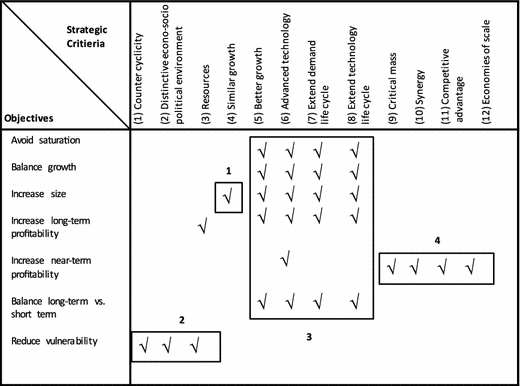
- 1.
Extension of the demand life cycle of the firm’s products.
- 2.
Extension of the useful life of the firm’s technology.
- 3.
Resource acquisition.
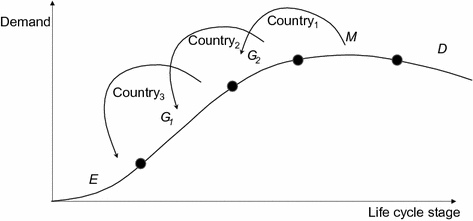
Extending demand life cycle
- 1.
The technologically and competitively turbulent emergence, E.
- 2.
The accelerating growth G1 during which demand typically exceeds capacity.
- 3.
The decelerating growth G2 which is highly competitive.
- 4.
The maturity M when demand reaches saturation.
- 5.
Decline D in the rare cases when the original demand (e.g., pagers) declines or disappears.
During E and G1 a firm’s energies are typically absorbed by the domestic markets. But during G2, when competition stiffens and growth decelerates, the extra costs of entry into a country where the demand is still in E or G1 may be more than offset by the attractive growth and profitability opportunities. By the time domestic demand reaches M or D, the pressures to move to countries in earlier stages of growth become strong.
Thus, firms which anticipate and conduct their internationalization in accordance with demand stages can extend substantially the life cycle of a firm’s product tine.
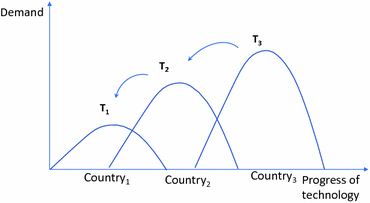
Extending technology life cycle
But experience in developing countries shows that premature transfer of technology to countries which are not ready to take advantage of it can lead to disastrous results. Use of internationalization to acquire resources has been much in the news and requires little comment. For example, moving manufacturing to low labor costs areas, or processing facilities near to sites of natural resources, has been a popular strategy. Firms have learned, however, that the labor cost advantages are not static and that it is necessary to anticipate that, as low-cost countries develop economically, labor costs will rise to make local manufacturing less attractive. Firms have also learned that nationalization tendencies, or insistence by local governments on joint ownership, can make investment in local processing and manufacturing highly risky and ineffective.
Box 1: The most restricted strategy is to internationalize into SBAs which have similar growth. This does not change the growth, profitability, or the portfolio balance of the firm.
Box 2: Entry into countercyclical SBAs, entry into distinctive political/economic/technological environments, or assuring availability of resources are the criteria which reduce the firm’s vulnerability.
Box 3: The firm’s near-term profitability is enhanced by SBAs which increase the size of the firm’s global market position, offer synergies, economies of scale, or other comparative advantages.
Box 4: Movement to better growth, and SBAs where technology is more advanced, and/or extending demand and technology life cycles are the most attractive strategic thrusts, because, as the figure shows, they have a comprehensive impact on the objectives.
Degrees of Internationalization
Stages of internationalization
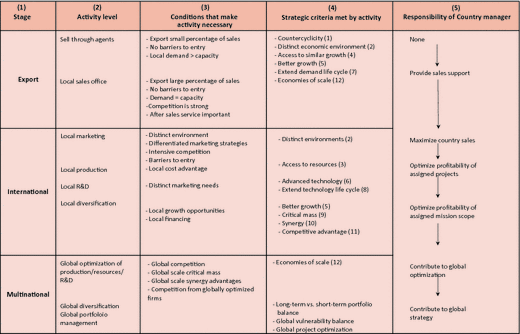
As the figure shows, the move toward the international status is a decentralization process in which activities are progressively distributed among the countries in which the firm does business.
By contrast, the step toward the multinational status involves assumption of new and major strategic responsibilities by the corporate office . But, unlike the popular interpretation, in well-run multinationals, this is not a recentralization which takes authority away from the country managers and product line managers. It is rather an enlargement of the overall corporate perspective and introduction of new relationships among parts of the company. In addition to retaining their own authority/responsibility scope, the lower managers are also made responsible for contributing to the global strategy of the firm.
As the figure shows, the first step toward the multinational stage is global optimization of the firm’s product lines, technologies, production and distribution systems (see the following section).
The second step is global strategic planning, in which the strategic business area portfolio is optimized from a global perspective.
The progression through the stages shown in Table 14.2 is a typical pattern which has been observed in the past. It reflects a step-by-step learning process which many firms have followed as a result of the factors discussed in the distinct aspects of internationalization. But the pattern does not imply that all firms do or should follow the respective stages, nor that an internationalized firm must expect to progress inexorably to the multinational posture. It is interesting to note that many of the very large American firms have not yet progressed beyond the international stage. One reason for this is that the American market had been dynamic and large enough to permit firms to fulfill most of their objectives domestically.
- 1.
From what Howard Perlmutter called ethnocentric focus, in which domestic culture dominates the firm, to a polycentric perspective in which the distinction between foreign nationals and foreign culture on the one side, and domestic nationals and culture on the other, disappears, and the firm develops a cadre of multinational managers and a genuinely multinational culture. American managements, accustomed to operating on a huge and culturally uniform domestic market, have frequently exhibited ‘cultural blindness’ when moving to foreign markets.
- 2.
The multinational stage also necessitates a shift to the matrix organizational form (see Chapter 17) in which the cherished and historically effective American concept of unity of authority and responsibility breaks down.
By contrast, limitations of the size of the domestic markets, the habit of doing business in culturally disparate environments, and a smaller commitment to the principle of unity of authority and responsibility have made it possible for major European firms to become fully multinational.
In part, the progression through stages of internationalization is forced by environmental conditions. The conditions which make each step necessary for success are shown in the third column of Table 14.2. The column shows, for example, that the firm can remain a successful exporter only so long as there are no barriers to entry, local products are undifferentiated and local market conditions are similar to the domestic market. When entry barriers appear, or local cost advantages become critical, the firm is forced to establish local manufacturing.
In general, a firm is forced beyond the export status whenever markets become differentiated, when entry barriers are high, and economies of size and synergies are global.
For a given firm, a quick diagnosis of the necessary degree of internationalization in a country can be determined by identifying the line in column 3 of Table 14.2 which best describes the conditions which exist in this country.
Column 3 determines the forced choice which a firm has to make in order to succeed. The voluntary choice of the stage of internationalization is determined by the strategic criteria of the firm. Column 4 of Table 14.2 shows the criteria which become possible at each activity level. (The numbers in parentheses refer to the numbering of the columns in Table 14.1.)
- 1.
Using the comprehensive list of objectives previously presented, determine the internationalization objectives of the firm.
- 2.
Using Table 14.1, determine the consequent strategic criteria .
- 3.
Using column 4 of Table 14.2, determine the degree of internationalization which will best meet the criteria.
The last column of Table 14.2 describes the progress of responsibilities which devolve on the country managers.
As the figure shows, the early steps in internationalization assign support and functional responsibilities to the country manager. He begins to acquire general management status when he is given the task of optimizing the profitability of the product line assigned to him. He reaches full general management responsibility when, on the one hand, he optimizes profitability in the mission scope assigned to him, and, on the other, contributes to the formulation of the global strategy of the firm. (As in the parent organization, the transition from a functional to general management perspective is not easy for a functionally trained and experienced manager.)
- 1.
How to make the trade-off between global economies of scale, made possible by optimization at the corporate level, and local market responsiveness, which requires products and market strategies tailored to the local conditions. We turn our attention to this problem in the following section.
- 2.
How to assign authority, and responsibility, when both corporate level units (such as product development) and country managers have legitimately conflicting perspectives on the overall corporate strategy.
Global Synergies vs. Local Responsiveness
As a firm moves toward the multinational stage of development, a key issue is the trade-off between global strategies which take advantage, on the one hand, of synergies, economics of R&D, and economies of scale in production and, on the other hand, strategies tailored to local country markets, and which permit optimal responsiveness to the local conditions and opportunities.
- 1.
Global, standard strategies which are applied equally to all SBAs. These may be optimal in undifferentiated product industries, such as natural gas, chemicals.
- 2.
Local, cosmetic strategies under which a standard product and marketing strategy are locally modified through packaging, specialized advertising/promotion, etc.
- 3.
Tailored strategies for large SBAs, standard for small. This is a mixed strategy, frequently observable in consumer product multinationals. It is used when the market size in a country reaches a level to permit local amortization of the product/market development costs. This type of strategy is forced on the firm in countries where the local government insists that the foreign entrant creates a distinct and integrated industrial entry in the host country.
- 4.
Interchangeability (modularity). The firm develops its strategies on a building block principle which permits different blocks to be packaged in response to special local conditions. This attractive strategy is difficult to implement as evidenced by the time, cost, and energy that Volkswagen has invested in its ‘world car’ concept.
- 5.
SBA-specific strategies are at the other extreme from global standard. A specialized strategy is developed for each SBA. This is the case of a multinational conglomerate which makes no attempt to relate similar divisions which operate in different countries.
Diversity of marketing strategy
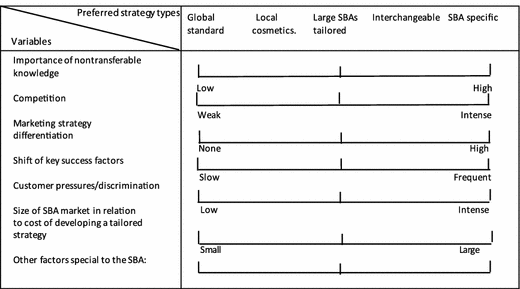
At the bottom of the figure room is provided for additional key variables which may be important in a given SBA. As the preceding remarks suggest, a profile of the key factors must be constructed for each SBA and then the overall degree of strategy diversity chosen, using the process we shall describe below.
Diversity of product-technology strategy

A comparison of Tables 14.3 and 14.4 shows that a firm must develop tailored strategies for both technology-intensive and competitively turbulent SBAs. But, if the pressures for local responsiveness can only be met through investments, which are not justifiable on the grounds of potential profitability, the firm may do better to stay out of the SBA rather than try to apply standard products which are not responsive to the local needs.
- 1.
Local production in which each country supplies its own needs.
- 2.
Global network in which production centers are established in certain countries, charged with the responsibility of producing for designated countries.
- 3.
Centralized production in which a single center (not necessarily the country of the firm’s headquarters) supplies global needs.
Diversity of production system
Alternatives Variables | Local | Global | Centralized |
|---|---|---|---|
Economies of Scale | Low | Significant | High |
Transportation costs | High | Significant | |
Tariff barriers | High | Significant | |
Balancing currency | Difficult | Significant | |
Legislation enforcing local productions | Stringent | Significant | Permissive |
Differential in labor costs | Low | Large | Low |
Differential in response costs | Low | Significant | High |
Other factors special to the firm production/distribution problems | |||
However, as recent experience in the electronic industry has shown, low-cost countries do not remain the lowest cost producers forever. In the long term, the design of the production system must anticipate shifts in costs and resource availabilities. For this reason, a global network which can divide risks and anticipate geographic shifts will frequently be the preferred solution, particularly if it also takes account of legislative and economic barriers. In the language of cybernetics, the global network provides the requisite variety solution to a complex and dynamic problem.
*Choosing the Strategy
Conceptually, the diversity of the firm’s marketing, product and production strategies should be chosen on the basis of a profitability analysis. The preferred strategy is one which will offer the best combined return on the investment over the lifetime of a product (or of a physical investment). In practice, though, the relevant variables (which include those of Tables 14.3, 14.4, and 14.5) are frequently difficult to quantify, the relations among them are poorly understood, and the uncertainties and risks are difficult to estimate.
In such situations, the technique of profile analysis used in the preceding chapters can offer a supplementary or even alternative approach to choosing the diversity of the marketing and the product-technology strategies and of the production/distribution system. (Readers who are mathematically minded will recognize that profile analysis assumes that return on the investment is a linear non-weighted function of the variables. If necessary, a refinement can be easily added by assigning relative priorities to the variables at the left-hand side of the respective figures.)
- 1.
Diagnose for each SBA the strategy profile which is optimal for the SBA, by constructing the appropriate profiles in Tables 14.3 and 14.4.
- 2.
Determine the strategic importance of each SBA to the firm’s future. This involves estimating its future contribution to the firm’s objectives, particularly to profitability, growth, and strategic invulnerability. (The estimate may be numerical or made by relative ranking of the SBA. For further details refer to Chapter 11.)
- 3.
Identify the large SBAs in which SBA-specific strategies are highly desirable.
- 4.
Estimate whether (and when) profits from these SBAs will be large enough to justify SBA-specific strategies . When this point is reached, the strategy development responsibility and the necessary resource should be assigned to the local managers of these self-contained SBAs.
- 5.
Use Table 14.5 in a similar manner to determine whether self-sufficient manufacturing and distribution responsibilities should also be assigned to these SBAs.
- 6.
For the remainder of small SBAs, choose a common product-technology strategy for each of the major product lines of the firm. Also identify the common elements of the marketing strategies which will be enforced equally among small SBAs.
- 7.
Without jeopardizing success in the large SBAs, establish the common elements of both strategies for both small and large SBAs. These will be the corporate strategies which will guide corporate level product-design and marketing strategy formulation.
- 8.
By balancing the costs and benefits of economies of scale, transportation costs, resource availabilities, local technological know-how, and currency differences and transfer barriers against one another, design an optimal global manufacturing and distribution network.
Shared Authority/Responsibility
In an exporting company, ‘standard’ domestically developed products are offered in all markets and there are no distinctive marketing strategies for different countries.
In an international company, the country manager is either expected to formulate his own strategy for marketing a product mix assigned to him by the corporation, or is given the additional freedom to determine and develop the appropriate product mix for his country.
As discussed in the preceding section, in a multinational company the strategy is based on a three-way trade-off between the demands of the local marketplace, the synergistic advantages of global R&D, and the economies of a globally optimized production/distribution system.
The process of arriving at a globally optimal strategy is made difficult by the inherent split of strategic authority and responsibility between country managers, product-technology managers, and managers of the global production system. If each is allowed to optimize the strategies along the dimensions for which he is responsible, the global balance will be distorted in favor of his area of responsibility.
In the past, much of the historical success of business firms (particularly in the USA) has been ascribed to the principle of unity of authority and responsibility. According to this principle, the firm’s performance will be optimal when certain key managers are given complete authority over decision making and implementation in areas assigned to them and are held responsible for the results.
Short of giving each country manager a total profit and loss responsibility (the case of the unrelated multicounty conglomerate described above), it is not possible to preserve this principle in a multinational firm. As a result, most multinationals have evolved three-dimensional matrix structures in which at least three key managers (and usually many more) must participate in joint-strategy formulation for each SBA for each country, and for the corporation as a whole.
While in a multinational matrix structure the principle of unity of authority /responsibility no longer applies, usually no formal substitute principle is put in its place. The strategic coordination is expected to occur through informal cooperation, based on mutual goodwill and a shared commitment to the global success of the firm. Experienced multinationals (such as Shell, Unilever, Nestle, IBM) have sought to assure mutual goodwill and commitment to the total enterprise by paying a great deal of attention to developing managers who share a common corporate culture . The result is a readily recognizable ‘Shell manager’ or an ‘IBM manager’ who resembles his colleagues and is distinct from managers of other firms.
As we shall be discussing in Part VI, development of a uniform corporate culture is a slow process. When strategic change is evolutionary and slow enough to permit timely cultural adaptation, assuring strategic consistency through shared culture and training is an effective method for resolving the inherent three-way conflict described above. But when strategic change becomes so discontinuous and fast, that cultural adaptation cannot keep pace with environmental change, experience shows that informal cooperation breaks down and the process of strategy formulation becomes dysfunctional and politically biased.
These difficulties can be ameliorated through strategic planning which develops new, commonly shared objectives as well as strategy guides for decision making (see Chapter 13).
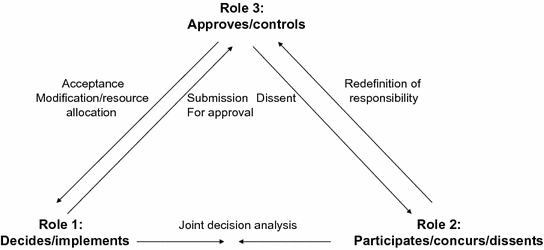
Role triangle in shared authority /responsibility
- (a)
is responsible for implementing strategic decisions assigned to him;
- (b)
is responsible for involving role 2 managers in a participative decision process;
- (c)
has the authority to make the final decision, whenever the participative process fails to produce consensus;
- (d)
is responsible for obtaining approval of the decision from role 3 manager.
- (a)
is responsible for participating in the decision process;
- (b)
is responsible for voicing dissent to role 3 manager, if the final decision is not acceptable to him;
- (c)
has the authority to ask role 3 manager for relief from responsibilities which he feels he cannot discharge, because of the decision made by role 1 manager.
- (a)
has the authority to override the decisions of role 1 managers;
- (b)
is responsible for modifying the area of responsibility of role 2 manager, when requested to do so by the latter.
For example, the product group manager is responsible for implementing the product-technology strategy . Since the manager responsible for global production, and several country managers, will be affected by product strategy decisions, the product group manager must involve them in strategy formulation. If consensus is not reached, the product group manager makes the final decision and obtains approval from his superior (the company president or vice president for R&D).
The production manager and the relevant country managers are responsible for voicing their dissent to the president (or their respective superiors reporting to the president). They also have the responsibility to ask to be relieved of certain responsibilities which, in their opinion, they cannot carry out effectively, in view of the decision made by the product group manager.
The president (together with the respective vice presidents to whom the lower managers’ report) has the authority to modify or reject the decision made by the product group manager. He is also responsible for redefining the responsibilities of the country managers and the production manager, as requested by them.
As can be seen from the above discussion, the shared authority /responsibility concept encourages consensus and consultation, but also provides for resolution of unavoidable conflicts and dissent.
Under the shared authority /responsibility concept, key managers will play different roles on different occasions, depending on the level and type of strategy being developed. This is illustrated in Table 14.5 which shows, for example, that a product division manager will play role 1 in product strategy decisions, and role 2 in marketing and production strategy formulation.
Examples of shared authority and responsibility
Roles Strategy type | 1 Decides/implements | 2 Partiipates/dissents | 3 Approves/controls |
|---|---|---|---|
Corporate | Corporate management | Board | Shareholders |
Product-technology | Product manager | – Country manager – Production | Corporate management |
Marketing | Country managers | – Product managers – Production managers | Corporate management |
Production | Production managers | – Product managers – Country managers | Corporate management |
Using a Progressive Commitment Process in Internationalization
As discussed previously, many firms internationalized by proceeding from exporting to progressive development of local marketing, manufacturing and R&D, to global design of the firm. An explanation for such a gradual approach is to be found in the cost of strategic information. As discussed, the cost of information for internationalization is very much higher than the cost of domestic information, and some of the vital knowledge about foreign environments can only be acquired through first-hand experience.
- 1.
The firm can learn by doing. Instead of investing in expensive market research , it invests in probing entries into an SBA and through experience acquires knowledge of the factors which are critical to success.
- 2.
Progressive commitment permits the firm to control risk by controlling the size of exposure.
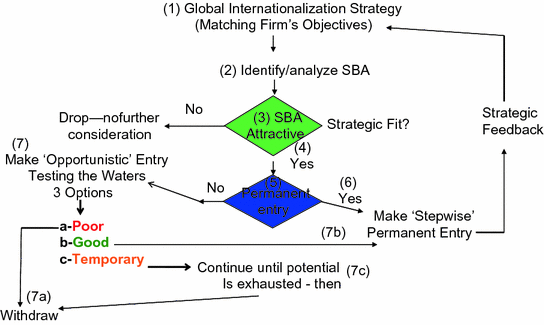
Gradual commitment
- 1.The first step is formulation of a global internationalization strategy which is in two parts.
- (a)
The portfolio strategy is derived, first, by matching the firm’s objectives to the strategic criteria and, second, by identifying geographic regions and specific SBAs which match the criteria. The portfolio strategy will specify some strategic business areas which the firm proposes to enter (or leave), but it will also specify the broad geographic regions and the characteristics of the SBAs which the firm will seek to enter.
- (b)
The global strategy also includes specification of diversity of product-technology strategy , the marketing strategy, and the production/distribution strategy.
- (a)
- 2.
The second step is to launch a search for SBAs which fit the global strategy .
- 3.
Each identified SBA is analyzed for its attractiveness on the basis of fit with the global strategy , fit with capabilities of the firm, feasibility , costs of entry, competitive intensity and the prospects for growth and profitability.
- 4.
The procedure for such analysis has already been described in Chapters 10 and 11.
It will lead to a twofold decision:- (a)
Whether to enter or leave the SB;
- (b)
What specific competitive strategy to pursue.
- (a)
- 5.However, in some cases information needed for a detailed analysis of an apparently attractive SBA may be prohibitively costly or even unavailable. Nevertheless, if such SBA appears very attractive, the firm may decide to make a low-cost opportunistic entry in order to ‘test the water.’ This step is illustrated at the left of Fig. 14.4. For example, the firm may find distributors for its present products, or make a sales agreement with a local firm. As Fig. 14.4 shows, an opportunistic entry ends in one of three outcomes:
- (a)
quick withdrawal, because the SBA cannot be made profitable;
- (b)
withdrawal after the temporary profit opportunity is exhausted;
- (c)
conversion to a permanent entry, if the long-term profit potential turns out to be attractive.
- (a)
- 6.
The opportunistic entry should be designed and executed as a strategic learning experience. This means that, while the firm attempts to make sales in the SBA, the major emphasis is not on making profit but on learning whether the opportunistic entry is potentially profitable in the short and/or in the long term.
- 7.
It may turn out that, while there are no long-term prospects in an SBA, a satisfactory profit can be made in the near term. In this case, the decision should be to continue selling in the SBA while the potential lasts, but to keep resource commitments at a minimum. For example, the firm would not build local production facilities or make any other capital investments.
- 8.
Returning to step 4, if sufficient information can be obtained at reasonable cost, which shows the SBA to be attractive, a permanent entry commitment can be made. Nevertheless, it is still advisable to proceed in steps using strategic learning at each step, but with more confidence and boldness, not only to confirm/deny the previous decisions, but also to modify the global internationalization strategy.
Management Capabilities for Internationalization
In the early stages of internationalization, the firm may make distribution agreements for export, or acquire distributing firms in foreign countries. While sales abroad may reach a high level, management capability changes little. The foreign sales are typically handled by an export department whose members develop and maintain foreign sales outlets and handle orders obtained from them.
If the export sales and profits continue to grow successfully, it is common to leave the total responsibility in the hands of the export department, while the corporate management devotes its attention to other matters. As a result, a paradoxical situation may arise in which the firm derives a substantial proportion of its sales and earnings from foreign countries whose social/economic/political/technological complexion is poorly (if at all) understood by the corporate management of the firm.
- 1.
The organizational culture should be change-seeking, flexible, with low commitment to the ‘way we’ve done it in the past,’ and prepared for and welcoming unfamiliar opportunities. In the ethnic sense of the word, the culture should be receptive to foreign values, points of view, and ways of doing business.
- 2.
Managers charged with internationalizing the firm should be entrepreneurial risk-takers, capable of identifying key success factors in an unfamiliar opportunity, tolerant of ambiguity, prepared to live with uncertainty, and to take calculated risks. They should be skilled in dealing with cultural/social/political factors which affect profit making in foreign countries.
- 3.
The firm’s information system should be global in scope, receptive to new and unfamiliar developments, and able to recognize important international differences. The information system should rely heavily on the local knowledge, perceptions, and judgments of managers who are ‘on the spot’ in different countries. It should contain not only economic/competitive, but also sociopolitical cultural data. It should not only contain quantitative but also qualitative judgment-based data.
- 4.
Strategic planning should be decentralized to permit country managers not only to formulate and implement their own strategies, but also to contribute their special insights into the global strategy . Strategy formulation should analyze political risks and cultural differences.
- 5.
The structure should be multifaceted, adaptable to different geographic conditions and different business areas.
- 6.
Managers’ roles should be defined according to the shared authority /responsibility principle.
- 7.
The rewards and incentives should be multiple, some recognizing efficient profit making, some rewarding imagination and entrepreneurial risk-taking. The system should be tolerant of the inevitable occasional failures which result from bold risk-taking.
- 8.
The overall management capability should be flexible and capable of self-renewal in response to changing foreign opportunities and circumstances.
It can be seen from the above description that the profile of multinational management capability has much in common with the profile needed in a societally responsive firm. As was seen in Chapter 10, the multinational capability profile also has many similarities to the profile required for success in a turbulent domestic environment.
Summary
The costs and risks of internationalization are high, as compared with domestic diversification. Therefore, we have argued that a firm seeking to internationalize itself should be clear about the objectives and the strategic thrusts it will pursue, and make sure that internationalization is the best way to pursue them.
The internationalization process typically proceeds through a gradual commitment to a local business presence. We have described the advantages and imperatives of the various stages of presence.
A major reason for the gradual commitment is the cost of information and ignorance about doing business in unfamiliar countries. We have described a stepwise procedure by which a firm can progressively commit itself.
When a firm reaches the multinational status, it begins to optimize its global strategy through a trade-off between global economies and local responsiveness. We have suggested procedures for determining the preferred level of diversity of global product/technology, marketing, and production/distribution strategies.
The principle of unity of authority /responsibility is very difficult to apply in a multinational. We have suggested a substitute principle of shared authority /responsibility .
A major obstacle to successful internationalization is frequently the lack of an appropriate management capability. This deficiency is often obscured by the fact that a firm which exports a large percentage of its sales perceives itself as already internationalized. We have identified the characteristics which management should have for successful internationalization.
Exercises
- 1.Prepare a checklist of new variables which should be added to a firm’s domestic environmental surveillance system in order to give the firm information about significant trends, threats, and opportunities in foreign markets.
- a.
In the checklist, identify the variables which belong in the category of implicit knowledge.
- b.
How and by whom should the foreign data be collected?
- c.
To whom, within the firm, should the data be distributed? How should the implicit knowledge be transferred to the headquarters of the firm?
- d.
What should be done to assure that the recipients use the data in their strategic decision making?
- a.
- 2.
In Table 14.1, checks are entered under each strategic criterion to shoe the contribution that the criterion makes to the respective objectives. Explain how internationalization entries make the contributions when they meet the following criteria: 3, 5, 6, 7, 9, 10. For which of the criteria will the contribution be automatic, once a foreign entry is made, and which require special management attention to realize the contribution?
- 3.
Explain the essential differences between exporting, internationalized, and multinational firm.
- 4.Consider separately a firm in the following industries: steel, cosmetics, automotive, and passenger aircraft.
- 5.
For each industry in exercise 4 above, use Table 14.5 to select the preferred design for the production system of a firm which operates in many countries.
- 6.Compare advantages and disadvantages of centralized authority/responsibility and shared authority/responsibility principles .
- a.
Prepare a checklist of factors under which one or the other principle should be used.
- a.
- 7.The German food giant Lidl has entered into the US market.
- a.Prepare a list of criteria which you think was used in making the following alternative entries types:
- i.
A large-scale permanent entry.
- ii.
Stepwise permanent entry.
- iii.
Opportunistic entry.
- i.
- b.
According to your criteria, which alternative should have been chosen?
- a.